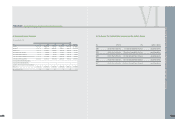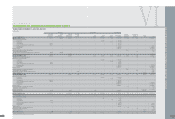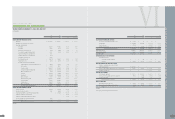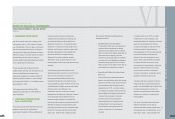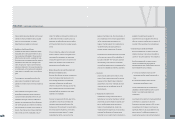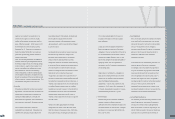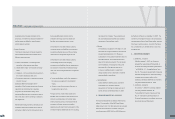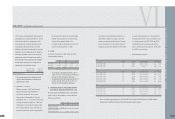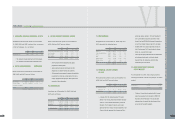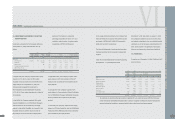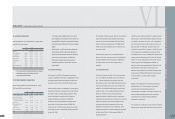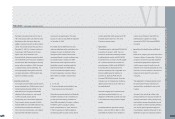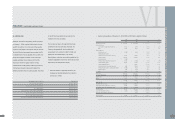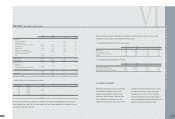HTC 2007 Annual Report Download - page 61
Download and view the complete annual report
Please find page 61 of the 2007 HTC annual report below. You can navigate through the pages in the report by either clicking on the pages listed below, or by using the keyword search tool below to find specific information within the annual report.
117116
AN OVERVIEW OFTHE COMPANY'S FINANCIAL STATUS
VI
marketing expenses or as a decrease in
revenues.
> R
e
s
e
rv
e
f
or W
a
rr
a
n
t
y Exp
e
ns
e
s
The Company provides warranty service for one
to two years depending on the contract with
customers. The warranty liability is estimated on
the basis of management's evaluation of the
products under warranty, past warranty
experience, and pertinent factors.
> Bonds P
a
y
a
b
l
e
Bonds are issued at face value and recorded as
bonds payable. Each month's interest expense
is booked at face value multiplied by the stated
interest rate. For bonds sold under repurchase
agreements, interest is calculated at the
repurchase value and recognized as interest
expense by period. The direct and necessary
expenses of issuing convertible bonds are
recorded as issuance expenses and amortized
from the issuance date to the maturity date. On
the conversion of convertible bonds,
unamortized issue costs, interest expense that
is accreted to the date of conversion but need
not be paid, recognized interest premium, and
the par value of the bonds are written off. The
common stock should be valued at the carrying
amount net of the amounts written off, and the
difference of this net amount from the par value
of the common stock is recognized as additional
paid-in capital.
> P
e
ns
i
on P
l
a
n
Under the ROC Labor Standards Law (the
"Law"), which provides for a defined benefit
pension plan, the Company has a pension plan
covering all eligible employees. Based on the
Statement of Financial Accounting Standards
No. 18 - "Accounting for Pensions" issued by the
Accounting Research and Development
Foundation of the ROC, pension cost under the
defined benefit pension plan should be
calculated by the actuarial method.
The Labor Pension Act (the "Act), which
provides for a new defined contribution plan,
took effect on July 1, 2005. Employees already
covered by the Law can choose to remain to be
subject to the pension mechanism under the
Law or to be subject to the Act. Under the Act,
the rate of an employer's monthly contribution to
the pension fund should be at least 6% of the
employee's monthly wages, and the contribution
should be recognized as pension expense in the
income statement.
> In
c
om
e
T
a
x
The Company adopted Statement of Financial
Accounting Standards No. 22 - "Accounting for
Income Taxes,"which requires an asset and
liability approach to financial accounting and
reporting for income tax. Deferred income tax
assets and liabilities are computed annually for
differences between the financial statement and
tax bases of assets and liabilities that will result
in taxable or deductible amounts in the future
based on enacted tax laws and rates applicable
to the periods in which the differences are
expected to affect taxable income. Valuation
allowances are provided for deferred tax assets
that are not certain to be realized. Income tax
expense or benefit is the tax payable or
refundable for the period plus or minus the
change during the period in deferred tax assets
and liabilities.
Adjustment of prior years' income tax is added
to current income tax expense in the year the
adjustment is made.
Income tax of 10% on unappropriated earnings
is expensed in the year of stockholder approval,
which is the year right after the year of earnings
generation.
> S
t
o
ck
-B
a
s
e
d Emp
l
oy
ee
Comp
e
ns
a
t
i
on P
l
a
ns
When the grant date of stock-based employee
compensation plans is on or after January 1,
2004, the Company applies the accounting
guidelines for stock-based compensation issued
by the Accounting Research and Development
Foundation of the ROC. Under these guidelines,
the fair value of option compensation is
recorded initially as an asset. This asset is
expensed ratably over the service period, which
is generally the period over which the options
vest.
> Tr
ea
sury S
t
o
ck
The Company adopted the Statement of
Financial Accounting Standards No. 30 -
"Accounting for Treasury Stocks," which
requires the treasury stock held by the
Company to be accounted for by the cost
method. The cost of treasury stock is shown as
a deduction to arrive at stockholders' equity,
while gain or loss from selling treasury stock is
treated as an adjustment to capital surplus.
When treasury stocks are sold and the selling
price is above the book value, the
differenceshould be credited to the capital
surplus - treasury stock transactions. If the
selling price isbelow the book value, the
difference should first be offset against capital
surplus from thesame class of treasury stock
transactions, and any remainder should be
debited to retained earnings. The carrying value
of treasury stocks should be calculated using
the weighted-average method.
When the Company's treasury stock is retired,
the treasury stock account should be
credited,and the capital surplus - premium on
stock account and capital stock account should
FINANCEI INDEPENDENT AUDITORS' REPORT
l


